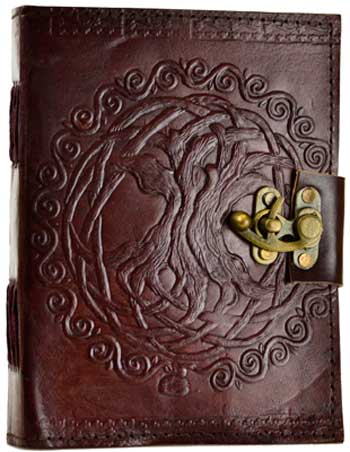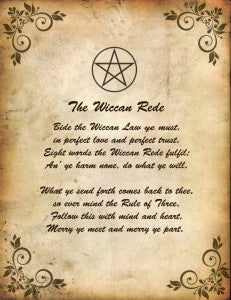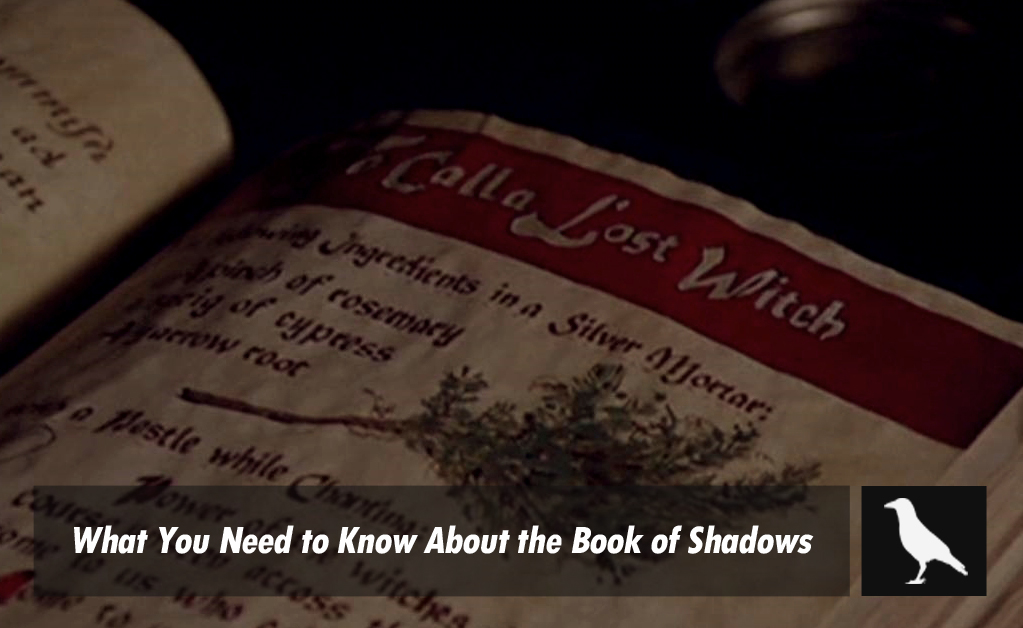In this post, we’re going to explore how to create your own Book of Shadows. What it entails and why it’s important for you…
What is a Book of Shadows?
You may have seen ancient Books of Shadows (BOS) in films and television shows (such as Charmed) where the book contains spells and a wealth of knowledge on various topics.
Your personal BOS is a space where you can document your spells and other rituals you wish to remember. Ideally, it should be written by hand, but we will delve deeper into this shortly. Your BOS is a sacred instrument. It represents power, and it’s essential to take proper care of it, much like any other magical item.

(Book of Shadows from The Moonlight Shop)
Should you purchase a pre-made Book of Shadows or create your own?
While it’s possible to buy a pre-made BOS, I genuinely wouldn’t advise doing so.
These books can often be “gimmicky,” with rituals and spells included that are more for entertainment than practical use.
No. You should manually write each spell. This not only channels energy to you as the creator but also aids memory retention.
Take your time documenting your spells. Treat this as a ritual in itself. Don’t rush; this also ensures your writing is legible for future reference.
Should you opt for a basic notebook or a more durable option?
First and foremost, you’ll need an empty book.
A simple notebook will work adequately, but since this is a sacred item that you may wish to cherish for a lifetime (and potentially pass down), it’s wise to invest in a quality BOS.
Some prefer using a 3-ring binder. While it may not be as attractive as a leather journal, it allows for easy modification of pages later on.
Others might maintain a binder or an economical notebook as their “draft,” subsequently transferring the rituals and spells to their more permanent BOS (the elegant durable option).

How do you begin your Book of Shadows?
Once you’ve made your choice and feel prepared, the first task is to inscribe your name on the opening page.
Some practitioners invest considerable time here. You need not spend ages, but keep in mind that this first entry will influence how your book evolves.
Many witches start with something like:
“This Book of Shadows belongs to [YOUR NAME]” followed by a quote or poem that holds significance for them.
What should you document in your Book of Shadows?
What and how you write in your BOS is entirely up to you.
Nonetheless, the following section covers aspects that are nearly universal among Wiccans and witches.
Guidelines and rules:
Your coven or the laws of your tradition: Yes, rules do exist in magic. They differ from one coven to another, but it’s wise to document them in your BOS, ideally at the front.
This part mainly serves as a reminder of what is appropriate in your coven (or tradition) and what is not.
If you practice alone, this is an excellent space to outline your personal “rules” for acceptable behavior.
Trust me, you will find this useful. There will be moments in your path as a witch when you’ll want to refer back to these “guidelines” to make informed choices.
This segment is also suitable for noting the Wiccan rede.

Dedication:
If you’ve been initiated into a coven, you can include a copy of your initiation ceremony here.
If you’re not part of a coven yet or if you’ve already devoted yourself to a deity, this is a fitting space to document that.
For some, this might extend across multiple pages, while for others, it may be a brief line with your name, the names of your deities, and the date.
I’d advise writing a few additional lines, explaining why you are dedicating yourself to your deities as well.
This segment of your BOS is also a good place to jot down legends about your gods, along with any relevant artwork or images.
Sacred Texts:
Your BOS serves as an excellent repository for ancient sacred texts. If you encounter a text that resonates with you, write it down. Many witches also use this area for documenting chants and traditional prayers.

Your Tables:
As a witch who engages in magic and spellcasting, your correspondence tables are among your most vital resources.
These might include phases of the moon, various colors and their meanings, herbs, etc.
Each element serves distinct purposes, and as time passes, it can be challenging to recall every detail.
Including charts in your BOS makes this information readily available when needed.
Herbs and Uses:
Any BOS should encompass a section dedicated to herbs— their names, appearances, and their uses.
Herbalism is a fundamental aspect of spellcasting. For millennia, people have relied on plants for various purposes. Over time, you’ll find uses for plants and herbs in healing, spell-casting, cleansing, and much more.
Magical Recipes:
This part caters to the “kitchen witch.” Here, you’ll write down recipes for crafting potions, oils, incense, or herb blends.
You can also include specific recipes for meals meant for Sabbat celebrations and similar occasions.
Rituals:
For most Wiccans and Pagans, the year features eight holidays. Document the rituals for each Sabbat; for instance, for Yule, outline how to celebrate the winter solstice. There are no requirements for complexity; it can be as detailed or straightforward as you prefer.
This segment is also reserved for your additional rituals, such as a full moon ritual.
Divination:
If you utilize Tarot, Runes, Scrying, or any other forms of divination in your practices, this is where you can keep that information. Many witches document their divination outcomes in their BOS, while others prefer maintaining that in a separate journal instead.

Spells:
Utilize this section to pen your spells. A helpful hint is to categorize them by purpose, such as prosperity, protection, healing, etc. This arrangement will simplify retrieval. Some witches employ color coding for better organization.
It’s worth noting that some practitioners prefer to keep their spells in a distinct book referred to as a “Grimoire.” If you’re a novice witch, you might find it simpler to consolidate everything in one book. However, follow what feels right to you, as long as it does not cause harm.
Closing thoughts:
Maintaining organization can be challenging. Establish a strong system from the onset, as this will significantly assist you.
A good practice is to credit your information sources (if applicable), as this may prove beneficial in the future.
I highly recommend that you acquire a robust, durable Book of Shadows right from the start. This book will accompany you for many years if it is built to last. While you can opt for a simple notebook or loose pages in a binder, they don’t offer the same essence.
Finally, keep in mind that your BOS is profoundly personal. Feel free to tailor it as you see fit. This article serves as a guide to help you begin. If you wish to modify the structure or add sections not mentioned here, that’s completely acceptable. It’s your book.
Feel free to leave a




I’ve recently felt the desire to join the Wiccan community, but I had no idea where to start with the Book of Shadows. This is incredibly helpful to any aspiring Wiccan!